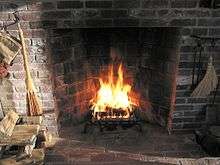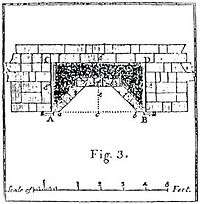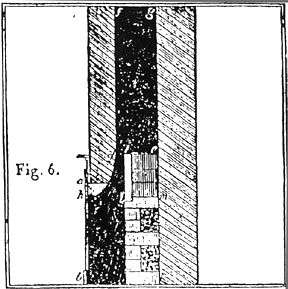Rumford fireplace

The Rumford fireplace is a tall, shallow fireplace designed by Sir Benjamin Thompson, Count Rumford, an Anglo-American physicist best known for his investigations of heat. Its shallow, angled sides are designed to reflect heat into the room, and streamlined throat minimizes turbulence, thereby carrying away smoke with little loss of heated room air.
History
Rumford applied his knowledge of heat to the improvement of fireplaces in the 1790s. He made them smaller and shallower with widely angled covings so they would radiate better. And he streamlined the throat, or in his words "rounded off the breast" so as to "remove those local hindrances which forcibly prevent the smoke from following its natural tendency to go up the chimney..."
Rumford wrote two papers[1][2] detailing his improvements on fireplaces in 1796 and 1798. He was well known and widely read in his lifetime and almost immediately in the 1790s his "Rumford fireplace" became state-of-the-art worldwide. Subsequent testing of Rumford's designs has shown that their efficiency would qualify them as clean-burning stoves.[3]
Principle of action


The Rumford fireplace created a sensation in London when he introduced the idea of restricting the chimney opening to increase the updraught. He and his workers changed fireplaces by inserting bricks into the hearth to make the side walls angled and added a choke to the chimney to increase the speed of air rising up the flue. It effectively produced a streamlined air flow, reducing turbulence so the smoke would go up into the chimney rather than lingering and often choking the residents. Many fashionable London houses were modified to his instructions, and became smoke-free as well as more efficient. Thompson became a celebrity when news of his success became widespread. In an age when fires were the principal source of heat, this simple alteration in the design of fireplaces was copied widely.


Usage
Rumford fireplaces were common from 1796, when Count Rumford first wrote about them, until about 1850. Jefferson had them built at Monticello, and Thoreau listed them among the modern conveniences that everyone took for granted. There are still many original Rumford fireplaces, often buried behind newer renovations. He also invented a cast iron stove, also known as the Rumford stove, which competed successfully with the famous Franklin stove. Both devices gave much more control over the air flow into the fire, and were both much more efficient users of fuel. Such stoves were expensive, but saved so much fuel as to justify the cost of installation very quickly. They in turn inspired the development of the kitchen range, also made in cast iron, which gave yet more control of the fire and also was used directly for cooking purposes.
References
- ↑ The Collected Works of Count Rumford; Vol. 2; Sanborn Brown, ed.; Harvard Univ. Press; 1969
- ↑ http://www.rumford.com/chimneyfireplacesa.html
- ↑ Ianto Evans; Linda Smiley; Michael G. Smith; Michael Smith (1 June 2002). The Hand-Sculpted House: A Philosophical and Practical Guide to Building a Cob Cottage. Chelsea Green Publishing. pp. 208–. ISBN 978-1-890132-34-7. Retrieved 22 February 2013.
Bibliography
- G I Brown, Count Rumford: The Extraordinary Life of a Scientific Genius, Sutton Publishing (1999).